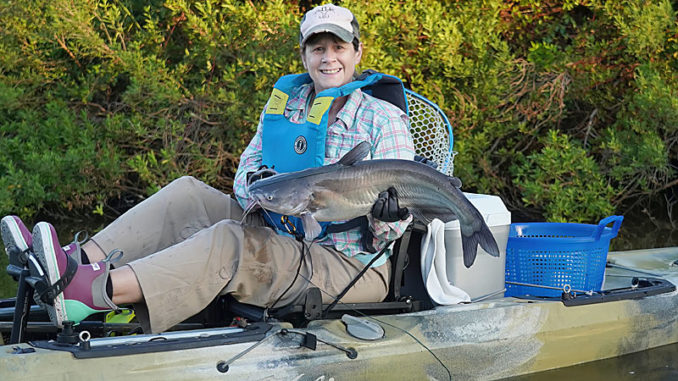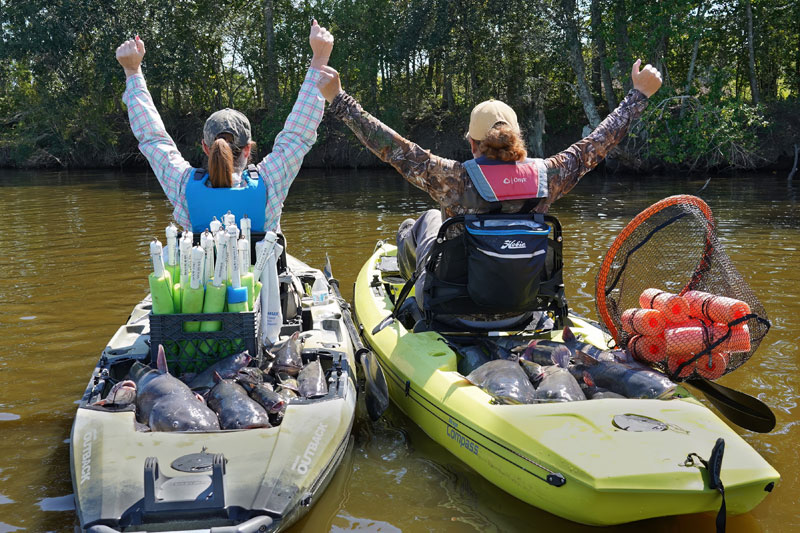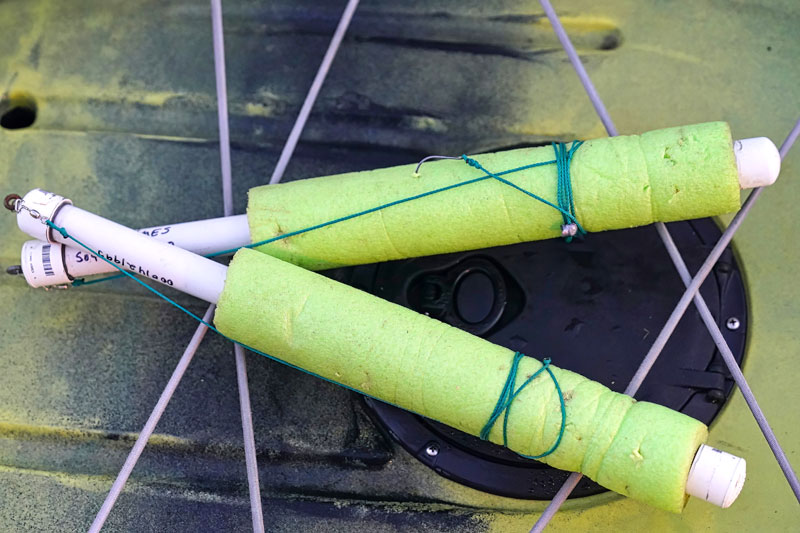
The “other” noodling lets anglers stay in the boat and on the catfish!
Starting Aug. 1, 2022, noodling became legal in Louisiana. This is the practice of getting in the water and grabbing catfish out of holes, logs, barrels, etc., with nothing but your hands. The sport is not for the faint-of-heart, or of sound mind.
Luckily, there is another form of noodling to catch bunches of catfish without risking life or limb. Using your kayak to set out a dozen or more baited pool noodles (or jugs), is a fun and exciting way to catch catfish. It is akin to a rodeo where you end up chasing down the floats as the catfish drag them around after being hooked.
The noodles
They can be as simple as a piece of pool noodle, an empty plastic jug, or a crafted pool noodle/PVC pipe combination. For the simple noodles, a length of tarred/dipped nylon twine is tied around the center of a 10-inch piece of large diameter noodle and a 4/0-8/0 circle hook is tied to the other end. Although not necessary, a 3/16 to 1/4-ounce bank or split-shot sinker can be added about a foot above the hook. Line length varies depending on the depth you’re fishing. I prefer four to six feet on average. The large float provides resistance to set the circle hook as the fish tries to swim away with the bait. Pool noodles are inexpensive, come in high visibility colors and the foam makes a convenient place to insert the hooks for storage and transport. If using plastic jugs, spray paint any clear jugs to make them easier to see.
For a more sophisticated set up, a 20-inch length of 3/4-inch PVC slid inside a 12-inch piece of small pool noodle works great. The noodle fits pretty snug around the pipe which is placed at the end of the pipe away from where your line is tied. Again, not necessary, but placing a 6-inch length of rebar inside the PVC before gluing on the end caps acts an indicator that you have a fish or that one may have taken your bait. Tip the noodle up and let the rebar slide to the end away from your line and lay the noodle flat on the water. When the fish hits, the rebar slides down the pipe and causes the noodle to stand in the water. The line can be tied directly to the PVC or you can add a small eye bolt and nut to the cap and seal the inside before gluing it on.
Tagging

Newly enacted regulations require the tagging of noodles and jugs as well as any other passive fishing gear. Each device must contain your name, phone number and fishing license number. This can be an attached waterproof tag or simply writing the information in permanent marker directly on the device.
The bait
Many types of commercial catfish baits are available. However, natural baits seem to work best. Shrimp and cut baitfish really can’t be beat, but large earthworms also work well in many areas. Don’t fill the circle hook with bait. Go sideways through a shrimp or edge of the baitfish chunk so that the barb is exposed and has room to rotate into the fish’s mouth as it pulls on the jug.
The location
That’s the good part. I don’t believe that there is a parish in Louisiana that doesn’t have somewhere to catfish. Of course, all of the freshwater lakes, ponds and bayous have catfish. However, many areas near the coast have also seen an explosion in the number of freshwater cats as these areas have become fresher due to diversions and other coastal restoration and protection projects. The lower salinities in these areas have brought an influx of various freshwater species. Many anglers fishing trout and reds are stumbling into some nice freshwater cats.
Free-floating the noodles is best in an area where they are somewhat confined. They can move around quite a bit simply due to the wind and current, and when hooked onto a fish, they can get out-of-sight quickly. Select a canal, bayou, cove or shoreline where you can keep them somewhat corralled.
Now the fun
I recently tagged along as “Catfish Queen” Robyn Bordelon and Vicki Holmes set out for a morning of the “other” noodling. Armed with a combination of PVC and plain noodles, they set the lines using shrimp, worms and cut mullet. Before the third or fourth noodle was out, one was already being pulled under. After a short chase in the kayak, Vicki hauled in a nice 6-pound blue cat.
The morning continued with chase after chase. While trying to work the noodles in a line as they were put out, it’s always best to chase down any jugs that you spot with fish on them. This keeps them from getting out-of-sight and also that initial grabbing of the jug helps set the hook if they were simply swimming away with the bait.

The cats were mixed from undersized, great eating size, to 10-pound brutes that really put up a fight on the end of a four foot string — with no drag. Then of course there was the usual variety of unknowns. One rogue noodle was spotted about a quarter mile down the canal and moving at a good clip. A quick pedal in the kayaks caught up with it, but as Bordelon got close, the noodle took off and disappeared under the water a-la Jaws. This went on for a couple minutes with the noodle disappearing and popping up several yards away each time.
Finally, Bordelon got hold of the noodle and was treated to a water shower while straining to get control of the unknown beast. Giant cat? Nope. A bruiser-size black drum. She wrestled it into the kayak as it wouldn’t fit in her net. A quick photo-op and it was released to fight another day. Other catches included small garfish, gafftopsail catfish and an eel.
Catfish can be caught year-round and provide great eating. Kayak noodling is an inexpensive, fun activity that can be done all across the state. No real fishing skills are needed and chasing them down as they swim away from you is a blast. A dozen basic catfish pool noodles can be made for about $25.
If someone asks you to go noodling catfish, make sure which method they mean. If they are going to be blindly grabbing fish from a hole, assess how much you really like your fingers. However, if it is in a kayak with baited, floating noodles, then don’t turn down the offer.
Louisiana Freshwater Catfish Regulations:
Minimum Length*:
Channel Catfish: 11”
Blue Catfish: 12”
Flathead Catfish: 14”
100 daily in the aggregate. A fisherman may possess up to 25 undersized catfish of the three species combined.*
* Check special creel and length regulations for Caddo Lake, Sabine River and Toledo Bend Reservoir


